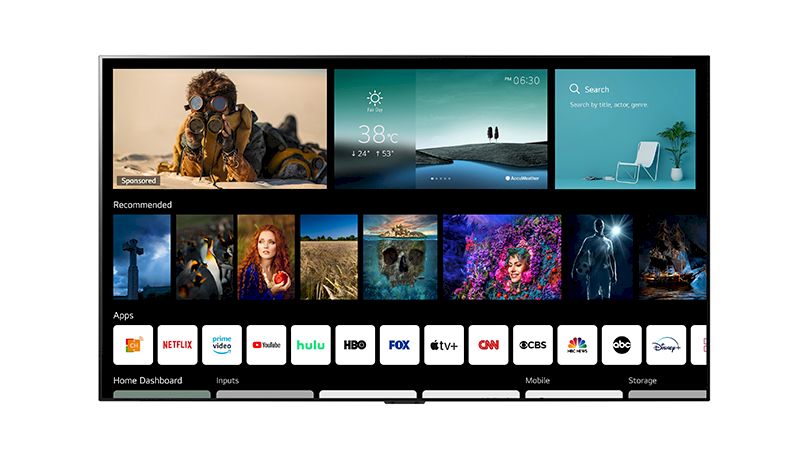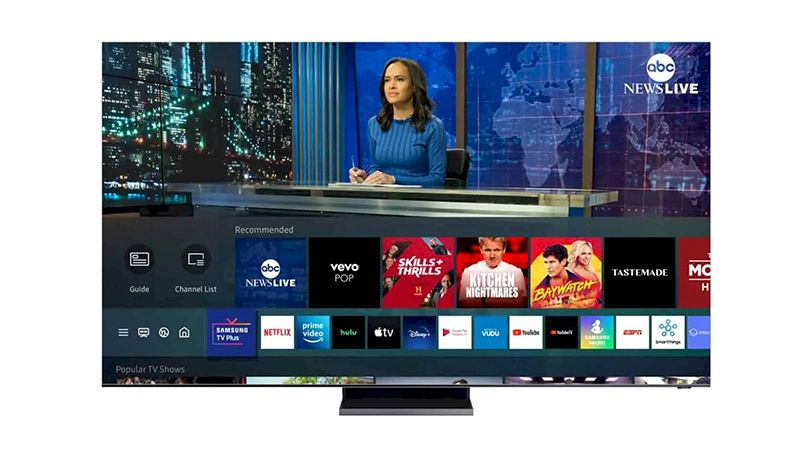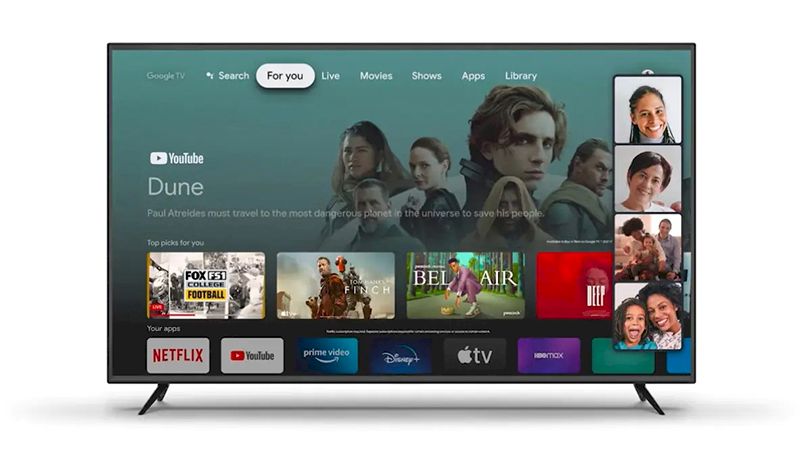WebOS vs Tizen vs Android TV

Thinking of buying a smart TV? This comparison between webOS and Android TV and Tizen will interest you because one of the keys to choosing a good TV is choosing the right operating system for you. While other brands use Android TV, Samsung and LG have their own systems.
Android TV is the operating system from Google and can be used by any brand, while WebOS is only seen on LG TVs like Tizen on Samsung TVs. These 2 Korean companies are the first handicap for the operating system but the truth is they are very strong brands in the market. The operating system isn’t taken into much consideration when buying a TV, and we understand that, but it plays a vital role in the user experience. For this reason, we bring you the comparison of webOS with Android TV and Tizen.
The importance of operating system in smart TV
Before starting the comparison, I would like to quickly touch on the importance of the operating system when choosing a Smart TV. In my experience (and many others), some brands have lost support for some apps because older models didn’t update their OS. The most used apps are usually video streaming services like YouTube, Netflix, Prime Video and now Disney+.
First of all, it is common practice to restore certain televisions by not updating the operating system or making the app market of that version obsolete. Endless incompatibilities from old versions cause problems accessing applications or crashing for no reason.
I won’t go further by saying that LG and Samsung are leaving many users with older mid and low range models whose app stores are pretty bad or whose apps are outright useless. I’m talking about this last decade, not models after 2010.
And one of its greatest weapons is to make a technologically obsolete product to “force” the consumer to upgrade by purchasing a new one. Now you will say “yes, but you can buy Chromecast or something like that”, it’s a great idea as a patch, but we must not forget that we paid thousands of dollars at the time to have a Smart TV with a good user experience.
Another issue is fluidity, interface, intuitive use, applications etc. understood as user experience. I’m not going to target Samsung and LG just because it seems unfair to me, when brands “throw” an operating system and abandon it, they do it anyway. So, what TV to buy and tomorrow a Chromecast, Xiaomi Stick, etc. I advise you to think very carefully whether it is worth the investment so that you do not have to buy it.
WebOS operating system

It’s a controversial name, but the truth is that Open comes from webOS, so LG released webOS in 2009 as “Palm webOS”, an operating system focused on the Palm Pre. It wouldn’t arrive on Smart TVs until 2013, but where it started to consolidate is from 2014, so any LG Smart TVs before that date can be considered obsolete.
While the user experience is more or less satisfactory depending on the television’s features, it’s a proprietary LG operating system that seems intuitive and friendly to me to use. I say this because the mid and low range of Smart TVs generally don’t have a very smooth experience (there’s a lot of lag), something that gets lost in every brand’s high range.
It is based on Linux and has a graphical interface based on HTML5, JavaScript and CSS. The latest version used in 2022 is webOS 6.0 and these evaluations are made according to this version.
Interface
By pressing the home button, we can reach an interface where webOS offers applications. Applications are presented to us with a system of horizontal application boxes like a taskbar. In the widgets under the applications we can see a preview of the interesting content for the user; For example, we will see the series we watched on Netflix or the most interesting news.
If we wish, we can prefer a horizontal taskbar that will appear every time the TV is turned on. So when the TV is turned on we can choose an application from there. B taskbar closes shortly.
webOS 6.0 is completely overhauled and features similar to the previous Android TV. This means that we will have an interface divided into rows with widgets and images. You have to “travel” more to go from top to bottom. While Android TV went further with Android 11, I now see webOS 6.0 as something more complex.
Applications
webOS is generally Android TV level, has many apps, Google and Alexa voice assistants. The first webOS has nothing to do with the current one, it must be said that the current one is very solid and complete.
Although LG doesn’t have webOS on any device other than a Smart TV, it offers a wide variety of apps, video games, and lots of utilities. Being a consolidated brand in the industry has enabled it to have many business partners that are connected to the operating system and develop applications for it.
Tizen operating system

This OS has a lot more menu navigation than webOS because Samsung used Tizen on their smartphones back in the day when Android wasn’t that established. Its official launch took place in 2015, it is based on GNU/Linux and Samsung has expanded it to smartphones, wearables, smartwatches and Smart TVs.
Samsung completes an ecosystem by producing its own panels, its own chips. In technology, Samsung is practically not dependent on anyone. I should point out that, at least in Samsung’s low range, Tizen offers a lot of latency, and I think it’s because they don’t equip TVs with enough hardware power.
Interface
From the moment we turn on the TV, it comes across as a wide horizontal bottom taskbar from which we can navigate through the main applications.
Applications
Although Tizen has a long way to go, the Smart TV operating system has the smallest application catalog among the 3 operating systems. WebOS is better when looking at available apps.
One of its advantages is SmartThings and I know this because I have had several Samsung devices. It is an ecosystem control with which we can synchronize Samsung devices more easily, play a channel on another TV (Samsung) in the house, manage everything with a smartphone.
Android TV operating system

We finished the Samsung comparison with webOS and Android TV with an operating system that is ubiquitous in smartphones, tablets, wearables, smartwatches and even cars.
Although the Linux-based operating system was previously called Google TV (in 2010), Google wasn’t the only one responsible for the project: Intel, Sony, and Logitech collaborated on the development of the operating system. For the same reason, you will find that most models of Sony televisions have Android TV.
It must be said that this operating system is seen not only on Smart TVs, but also on TV Boxes or Sticks such as Xiaomi Mi Stick, Mi Box, Chromecast, and countless devices of thousands of brands.
Chromecast is a concept that has been a major success for Google: seamlessly stream content from devices to TV, with or without mirroring. The big positive point of Android TV is that they never let you down and they always update the operating system, so the software will be a feature we never have to worry about.
Interface
This operating system changes a lot compared to the other 2 and I must say that it has changed even more with the last update.
To quickly search for what we want, we have tabs at the top such as Search, Home, Explore and Apps, the middle panel for the app drawer, middle down, we have suggestions for each app that we can access directly to save time.
Honestly, I have to congratulate Google for improving the interface a lot.
Applications
It is the operating system with the most applications, installing the most updates and the most versatile of them all. Any Android TV is super fast and easy to sync and we can find very interesting applications.
In this respect there are the most famous streaming services and much more. Everything seems perfect, but there is always a “but”: optimization. I think the operating system where we see the most lag, which can conclude that the hardware is not enough, has the most graphics load.
WebOS vs Tizen vs Android TV, which is the best?
If I had to choose, I would say Android TV because it is more updated, has more apps, and because of the ecosystem it offers to those with an Android smartphone or tablet. Secondly, I would prefer LG’s WebOS, which is a very elaborate operating system that works quite well and has no flaws.
On the other hand, I believe that Tizen’s intuitive system should be improved as well as its optimization. It sounds like the worst of the three to me and somehow overshadows the user experience that can be extracted from a good QLED or Neo QLED with Quantum Matrix Technology.
However, should Android TV be considered the best option? If we talk about OS, yes; On the other hand, if we are going to talk about cost, we need to make a criticism. As we have seen, and with the exception of some Chinese brands such as Xiaomi, TVs with Android TV are more expensive.
This is where the webOS and Tizen vs Android TV comparison becomes important because it matters what to prioritize when buying a TV. My idea is that the order is this way:
- Panel and backlight technology (unless OLED).
- Size (Inches).
- Compatible HDR formats.
- Operating system.
- Inputs (USB, E-ARC, HDMi etc.).